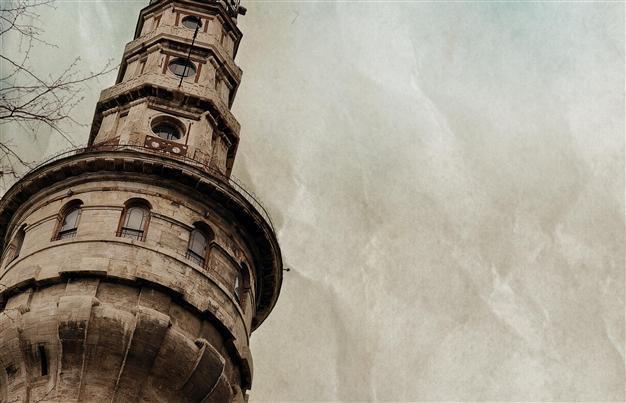Istanbul's Beyazıt Tower to become a museum
ISTANBUL - Anatolia News Agency

The Beyazıt Tower hosts Istanbul University students every Friday.
Istanbul’s Beyazıt Tower, which was used as a fire-watch tower in Ottoman times, may return to being a museum, according to Istanbul University’s public relations manager, Ergün Yolcu.Work has begun to transform the tower into a museum, Yolcu said, speaking to Anatolia news agency.
“We have applied to the Tourism and Culture Ministry and sent the necessary documents. The Beyazıt Tower is a world cultural heritage site. What we aim to [do is] open the doors of the university and within it the tower to visitors and museum-goers.” The venue must be attached to the Tourism and Culture Ministry in order to be opened as a museum, he said.
The aim of the project is to share the cultural heritage of the tower with visitors, Yolcu said. “Visitors will come through the Süleymaniye door, pass the restored historical monument, and walk through the gardens,” he said, describing how future visitors might enter the tower museum.
The Beyazıt Tower, which was built in 1749, now hosts Istanbul University students every Friday, who take pictures from the tower.
Also known by the name “Seraskier Tower,” the title of the Ottoman minister of war, the historical tower is located on Beyazıt Square, known as the Forum Tauri in the Roman period, in the courtyard of Istanbul University’s main campus, which was formerly the location of the Ottoman Ministry of War. The tower sits on top of one of the seven hills on which Constantine the Great built the city, following the model of Rome.
The construction of the Beyazıt Tower was ordered by the Ottoman Sultan Mahmud II, who reigned from 1808-1839, and it was designed by Senekerim Balyan, who built the current tower from stone in 1828 in the same location as the original wooden tower, which had been destroyed in a fire. The original tower had been constructed by the architect’s brother, Krikor Balyan.
The 85 meter-tall tower is currently equipped with a lighting system to indicate weather conditions in different colors. “There are 180 steps and it is very hard to go up, but the view of Istanbul is worth it,” said Yolcu. The Istanbul fire department continued to use the building up until 1993, said Yolcu, and the tower still houses an information system belonging to them.
History of the tower
Fire has been a major threat throughout Istanbul’s history, and caused numerous wide-scale disasters, as most houses in the Old City’s historic quarters were originally built from timber. The Beyazıt Tower, the Galata Tower in Beyoğlu, and the İcadiye fire tower on Vaniköy Hill were used to spot threats of fire as they commanded long-distance views of the city from above the rooftops. From Beyazıt Tower one could see the entire Old City, including Yedikule, Topkapı, Kocamustafapaşa, Fatih and Beyazıt, a cross-section of the Golden Horn districts, such as Fener, Balat and Eminönü, and those of the Bosphorus, including Tophane, Beşiktaş and Ortaköy, as well as Üsküdar and Kadıköy at the entrance to Marmara Sea and even the Princes’ Islands towards the southeast of the city.
During the daytime, warnings of fire were signaled by lowering baskets from the tower, while at night colored lamps were lit. The number of the baskets or the number and color of the lamps indicated in which district of Istanbul fire had broken out. The watch tower at İcadiye on the Anatolian side of the Bosphorus would then fire 7 volleys to inform the citizens of the fire, in response to warning signals from Beyazıt Tower. Until 1923, 20 firefighters were stationed in the Beyazıt Tower. In 1997, the structure underwent a thorough restoration.
Today the Beyazıt Tower is still in use as a watchtower. It also operates as a signal for forecasted weather and provides maritime navigation information to ships on the Golden Horn at night. With the development of advanced communication technology, however, the tower has lost its importance. Nowadays only two firefighters are stationed in the tower on three shifts for protection purposes only. Since 1972, special permission has been required to enter the tower.
Beyazıt Tower in contemporary Istanbul life
The tower’s lights currently change colors according to the weather. “When there is snow the tower becomes red, yellow means fog and green means there will be rain. Blue means there will be a sunny morning,” said Yolcu.
When Rector Yusuf Söylet started his term at Istanbul University he promptly organized the restoration of the tower, said Yolcu. The restoration work ended two months ago, and currently the tower is being prepared to welcome the public. “The tower is a part of the lost silhouette of Istanbul,” said Yolcu.
As of now students of the university are the only visitors the tower has. Each week a select number of students are allowed to make the long climb up the tower in order to take photographs. “Until the tower becomes a museum, every Friday 30 students will visit the tower and take photographs of Istanbul. Fifteen students come to the tower at 2 p.m., and 15 students at 3 p.m.,” Yolcu said. The students’ photographs will be displayed in an exhibition when the tower opens as a museum, according to Yolcu.
















